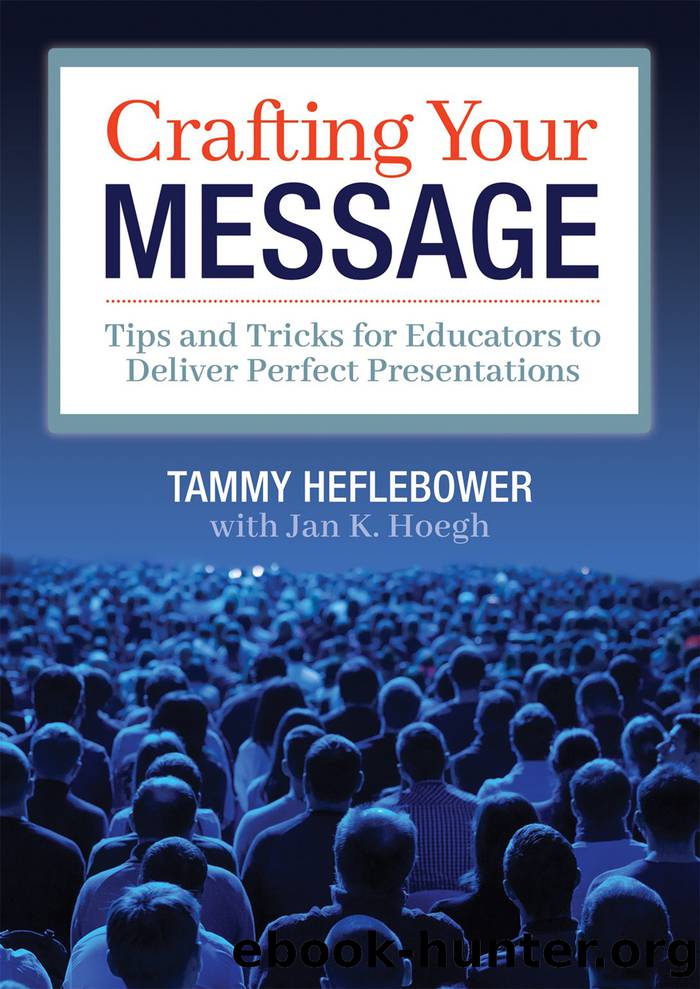Crafting Your Message by Heflebower Tammy;

Author:Heflebower, Tammy;
Language: eng
Format: epub
Publisher: Solution Tree
Published: 2019-08-15T00:00:00+00:00
Model Professionalism
Exude verbal and nonverbal behaviors you would expect of the utmost professional. Speak about what you know about, and tread lightly around those things you donât. Keep your voice neutral during more heated conversations or situations, and work so others cannot easily read any negative emotionsâeven when they are brewing inside. You might need to practice this neutral face by looking in a mirror while imagining an incident that evoked some negative emotion. Notice how you look. What is your posture? Is your brow furrowed? Could anyone tell how irked you are? Some emotion is naturalâyou donât want to look like a paralyzed, expressionless statue. Yet, an overly emotional presenter triggers stress within the audience members.
Professionalism means you speak kindness to your group, even if some jabs come your way. As Valorie Burton (2016) says,
If the person with whom you are conversing is foolish, speaking nonsense, and attempting to engage you in conversation that will require you to stoop down to a level of ignorance, do not engage. Ease out of the conversation, decline to comment, or walk away. Anything you attempt to say in such a situation will likely only escalate the conversation. (p. 147)
Itâs fine to have and use an assertive tone to make a point or calmly dispute a heckler, but never allow it to move into frustration or anger. Youâll come off like a tantrum-throwing toddler. Use strategies to deflect apparent verbal throw-down traps. One I like is called critical issues. I simply write that title on a large piece of chart paper, and I add the concern or issue (quoted by the individual, as best I can, as it emulates his or her voice and topic, not yours) to the chart paper. This allows you to honor it, yet place it elsewhere for later and further discussion. It stops an argument and allows you to get back on track. This strategy is great to use when someone raises an irrelevant issue or an emotional one, and you want to note it but not deal with it at that time. I keep the same chart paper up throughout the training. Time permitting, I will either address the issue(s) right after lunch or a break, as a quick transition. Or, I may ask the person with the critical issue to see me during a break or at the conclusion of the training to offer information about a topic that is important, yet not pertinent to the entire group. Sometimes, it is an issue about which needs attention from the school or district team.
Monitor your use of your personal devices. Only use them when you would desire your audience to do soâat breaks, during lunch, and at the conclusion of the session. Not only can these devices be a mental distraction for you, but using them outwardly sends a message that the training at hand is not important. Itâs subtle, yet remember you are always being observedâeven during breaks.
During breaks and lunch, refrain from any gossip or judgment about others.
Download
This site does not store any files on its server. We only index and link to content provided by other sites. Please contact the content providers to delete copyright contents if any and email us, we'll remove relevant links or contents immediately.
The Art of Coaching Workbook by Elena Aguilar(48572)
Trainspotting by Irvine Welsh(20140)
Twilight of the Idols With the Antichrist and Ecce Homo by Friedrich Nietzsche(17754)
Fangirl by Rainbow Rowell(7893)
Periodization Training for Sports by Tudor Bompa(7376)
Change Your Questions, Change Your Life by Marilee Adams(6702)
This Is How You Lose Her by Junot Diaz(5845)
Grit by Angela Duckworth(4777)
Red Sparrow by Jason Matthews(4734)
Asking the Right Questions: A Guide to Critical Thinking by M. Neil Browne & Stuart M. Keeley(4642)
Paper Towns by Green John(4209)
Room 212 by Kate Stewart(4152)
Ken Follett - World without end by Ken Follett(4003)
The Sports Rules Book by Human Kinetics(3630)
Housekeeping by Marilynne Robinson(3456)
The Motorcycle Diaries by Ernesto Che Guevara(3380)
Introduction to Kinesiology by Shirl J. Hoffman(3329)
Exercise Technique Manual for Resistance Training by National Strength & Conditioning Association(3329)
Papillon (English) by Henri Charrière(3324)
